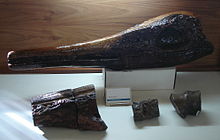Platypterygius ('flat flipper)' is an ichthyosaur of the family Ophthalmosauridae. It was the last surviving ichthyosaur.[2][3]
| Platypterygius | |
|---|---|

| |
| Skull of P. sachicarum in the Paleontological Museum in Villa de Leyva, Colombia | |
| Scientific classification | |
| Kingdom: | |
| Phylum: | |
| Class: | |
| Order: | |
| Family: | |
| Subfamily: | |
| Genus: | †Platypterygius von Huene 1922
|
| Species | |

Discovery and species
changeFossils are known from Australia, Russia, United States of America, Colombia,[4] Western Europe and possibly New Zealand. There are seven named species. Both adults and juveniles have been unearthed, including newborns and pregnant females. Like other ichthyosaurs, Platypterygius gave live birth.
Palaeobiology
changePlatypterygius reached a length of about 7 m (23 ft). It had a long snout and a powerful finned tail. There are more digits in the front flippers than is usual in ichthyosaurs; they are tightly bound in rows, giving a broad, flat appearance. This unusual characteristic gives the genus its name, meaning 'flat wing.' Furthermore, some of the wrist bones have disappeared entirely. CAT scans on a juvenile specimen strongly suggest that Platypterygius was deaf.
Extinction
changePlatypterygius became extinct during the Upper Cretaceous, about 30 million years before the K/T extinction event. There was an ocean anoxic event at the Cenomanian–Turonian stage boundary. The deeper layers of the seas became anoxic and poisoned by hydrogen sulphide (H2S). As life died off in the lower (benthos) levels of the sea, so did the predators at the top of the food chain. The last pliosaurs and ichthyosaurs became extinct.[5]p251
No firm reasons can be given for the decline of the ichthyosaurs. By the Cretaceous they certainly had more competitors than in the Triassic, and more elusive prey. The adaptive radiation of teleost fish meant their new prey were fast swimming and highly evasive. The teleosts also included fast-swimming predatory fish, which must have been competitors. The anoxic event would have removed much of the plankton at the base of the food chain. That would certainly result in the extinction of many larger predatory forms of life.
References
change- ↑ Arkhangelsky et al., 2008
- ↑ Fernández M. 2007. Redescription and phylogenetic position of Caypullisaurus (Ichthyosauria: Ophthalmosauridae). Journal of Paleontology 81 (2): 368-375.
- ↑ Arkhangelsky M.S. et al 2008. On ichthyosaur remains from the Cretaceous of the Voronezh region: Paleontological Journal, 42, 287-291.
- ↑ Páramo M.E. Platypterygius sachicarum (Reptilia, Ichthyosauria) nueva especie del Cretácico de Colombia. Revista Ingeominas 6, 1997: 1–12
- ↑ Benton M.J. 2004. Vertebrate palaeontology. 3rd ed, Blackwell, Oxford.
- Long, J.A., Dinosaurs of Australia and New Zealand, UNSW Press, Australia 1998